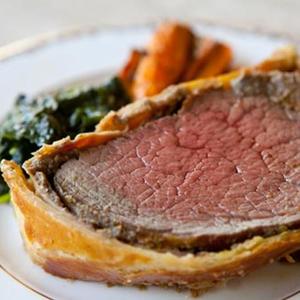Ingredients
Equipment
Method
- Season the beef tenderloin generously with salt and pepper, then sear vigorously in a hot, oiled skillet until deeply browned on all sides. Allow to cool, then brush evenly with yellow mustard.
- Finely chop the mushrooms in a food processor. Cook the chopped mushrooms in the same skillet until all moisture evaporates and the mixture is very dry, forming a duxelles. Season well and cool completely.
- Lay out overlapping sheets of plastic wrap on a clean surface, then arrange the Parma ham slices into a neat rectangle on top of the plastic wrap.
- Evenly spread the cooled mushroom duxelles over the ham layer.
- Place the seared and mustard-coated beef tenderloin at one end of the duxelles-covered ham.
- Using the plastic wrap, carefully roll the ham and duxelles tightly around the beef, forming a compact log. Twist the ends of the plastic wrap to secure and chill for at least 30 minutes.
- On a lightly floured surface, roll out the puff pastry into a rectangle large enough to fully encase the beef log.
- Unwrap the chilled beef log and carefully place it onto the rolled-out puff pastry. Wrap the pastry tightly around the beef, trimming any excess and securely sealing all seams.
- Transfer the pastry-wrapped beef to a baking sheet lined with parchment paper. Brush generously with beaten egg yolk and score the top of the pastry decoratively. Chill again for 15-20 minutes.
- Bake in a preheated oven (around 400°F/200°C) for approximately 30-40 minutes, or until the pastry is golden brown and flaky, and the internal temperature of the beef reaches 125-130°F (52-54°C) for medium-rare. Rest for 10-15 minutes before slicing and serving.
Notes
For an exceptional Beef Wellington, quality ingredients are paramount, especially the beef tenderloin. Sear the beef aggressively to develop a rich crust, contributing significantly to flavor. The mushroom duxelles is critical: ensure it's cooked until very dry to prevent a soggy pastry, seasoning it generously. Keep the puff pastry chilled at all times for best flakiness and ease of handling; any tears should be repaired quickly. A crucial step is using a meat thermometer to achieve the desired doneness, targeting medium-rare (125-130°F / 52-54°C) for the beef's internal temperature before resting. Resting allows juices to redistribute, ensuring a tender and moist center. The ham not only adds a salty counterpoint but also acts as a barrier, protecting the pastry from moisture. Score the pastry elegantly for visual appeal.
